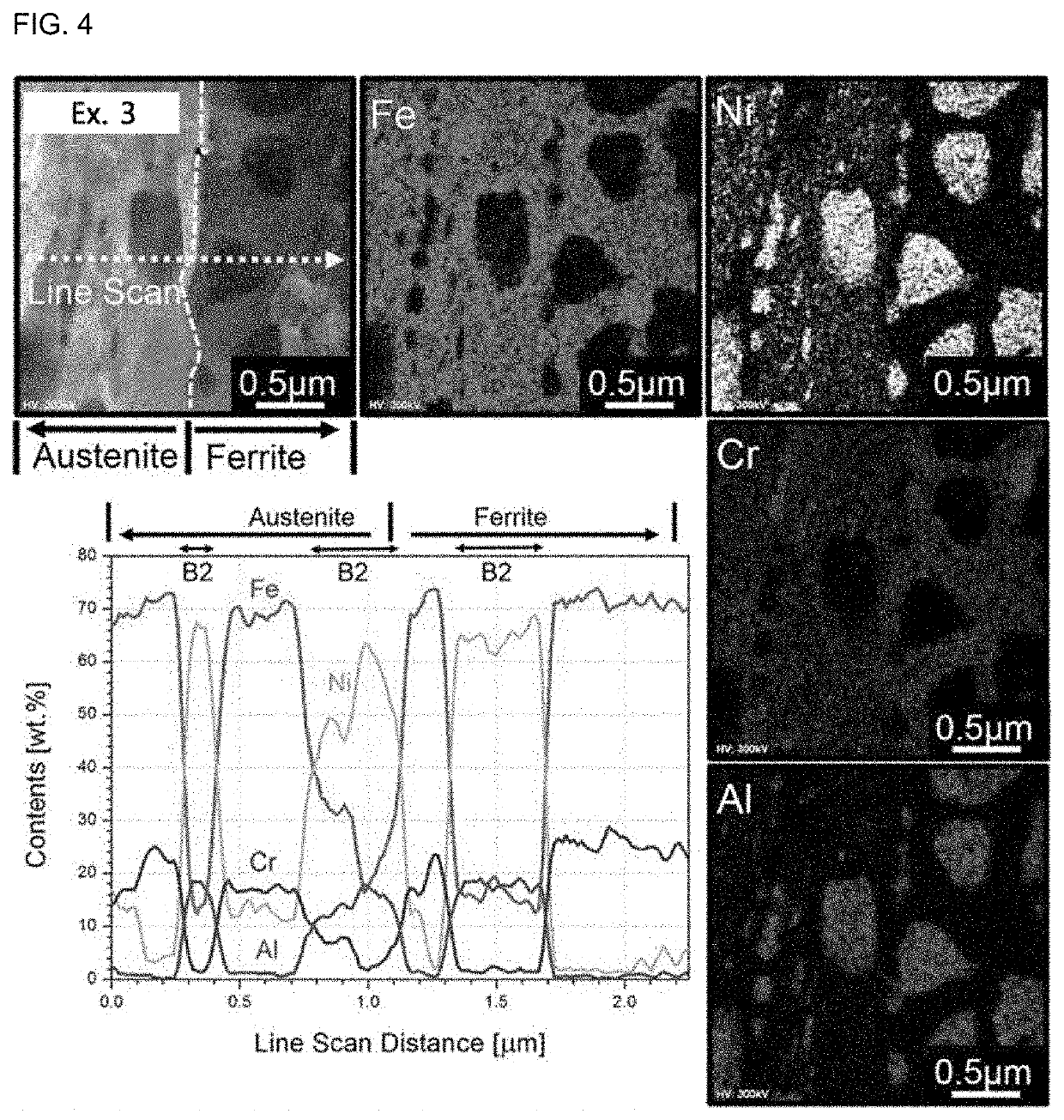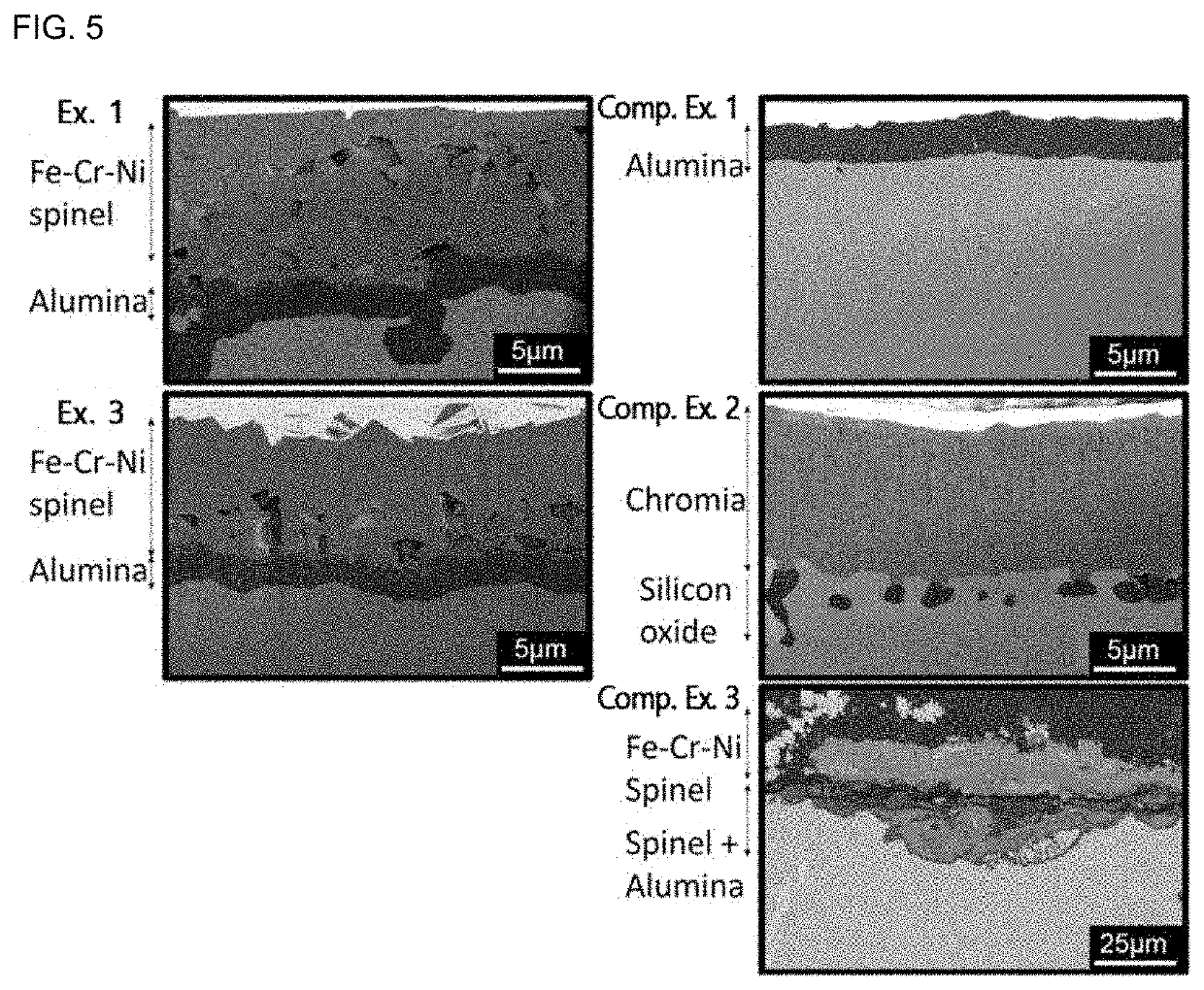HIGH-STRENGTH Fe-Cr-Ni-Al MULTIPLEX STAINLESS STEEL AND MANUFACTURING METHOD THEREFOR
a technology of fe-cr-ni-al multiplex stainless steel and manufacturing method, which is applied in the direction of greenhouse gas reduction, furnaces, heat treatment apparatus, etc., can solve the problems of accelerating the collapse of the nuclear reactor core, deterioration of mechanical properties of fecral alloy, and the risk of the containment building being damaged, etc., to achieve excellent accident tolerance, excellent mechanical properties and anticorrosion properties, excellent integrity as a structural material
- Summary
- Abstract
- Description
- Claims
- Application Information
AI Technical Summary
Benefits of technology
Problems solved by technology
Method used
Image
Examples
example 1
Al Alloy
[0060]First, 46.67 wt % of iron (Fe), 23.64 wt % of chromium (Cr), 24.15 wt % of nickel (Ni), 5.54 wt % of aluminum (Al), and, based on 100 parts by weight of the combination of iron (Fe), chromium (Cr), nickel (Ni) and aluminum (Al), 0.48 parts by weight of Nb, 1.01 parts by weight of Mn, 0.12 parts by weight of C, 0.31 parts by weight of Si and 0.0080 parts by weight of Ti were melted by using a vacuum induction melting reactor under argon atmosphere of 450 torr at a melting temperature of 1300° C. for 2 hours. Then, 42 kg of the ingot were subjected to homogenization and solution annealing heat treatment in an air furnace at 1200° C. for 3 hours and then subjected to furnace cooling to obtain blocks having a thickness of 30 mm. After that, hot rolling was carried out at 1150° C. eight times to obtain an alloy having a thickness of 3 mm.
[0061]The rolled alloy was preliminarily heat treated at 1200° C. for 3 hours and quenched. Then, cold rolling was carried out to obtain a...
example 3
Al Alloy
[0063]Example 1 was repeated to obtain stainless steel, except that 58.76 wt % of iron (Fe), 16.33 wt % of chromium (Cr), 18.77 wt % of nickel (Ni), 6.14 wt % of aluminum (Al), and based on 100 parts by weight of the combination of iron (Fe), chromium (Cr), nickel (Ni) and aluminum (Al), 0.53 parts by weight of Nb, 1.04 parts by weight of Mn, 0.11 parts by weight of C and 0.31 parts by weight of Si were used.
example 4
Al Alloy
[0064]Example 1 was repeated to obtain stainless steel, except that 47.9 wt % of iron (Fe), 17.28 wt % of chromium (Cr), 28.69 wt % of nickel (Ni), 6.13 wt % of aluminum (Al), and based on 100 parts by weight of the combination of iron (Fe), chromium (Cr), nickel (Ni) and aluminum (Al), 0.56 parts by weight of Nb, 1.03 parts by weight of Mn, 0.11 parts by weight of C and 0.30 parts by weight of Si were used.
PUM
| Property | Measurement | Unit |
|---|---|---|
| melting temperature | aaaaa | aaaaa |
| temperature | aaaaa | aaaaa |
| melting temperature | aaaaa | aaaaa |
Abstract
Description
Claims
Application Information
 Login to View More
Login to View More - R&D
- Intellectual Property
- Life Sciences
- Materials
- Tech Scout
- Unparalleled Data Quality
- Higher Quality Content
- 60% Fewer Hallucinations
Browse by: Latest US Patents, China's latest patents, Technical Efficacy Thesaurus, Application Domain, Technology Topic, Popular Technical Reports.
© 2025 PatSnap. All rights reserved.Legal|Privacy policy|Modern Slavery Act Transparency Statement|Sitemap|About US| Contact US: help@patsnap.com



